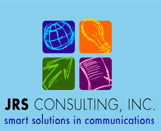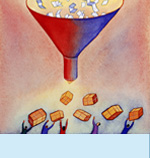


  |
||||
|
PRINTER FRIENDLY VERSION Your Job Beyond the Charts and Graphs Easy for you and priceless for them: Five ways to be a hero to your clients. There's nothing like a younger brother for providing humbling experiences. My own once made the following comment regarding my research business, "Actually you're kind of like Mr. Haney in the Green Acres TV show -- you know the guy who operates all of those different businesses, depending upon whatever the customer wants. You're in the research business, you're in the sales business, and you're a consultant, a writer and a coach." After swatting him in the head the way a big sister is perfectly entitled to do (if you've ever seen Mr. Haney, you'll understand), I actually had to agree with this assessment. The research business obviously involves much more than doing research. It's about meeting the internal or external client's needs - and that usually means going much further than designing and conducting research. Here are five easy ways you can make a little extra effort and be a hero to your clients: 1. Get beyond the research jargon to describe your work in a way that your client understands. Advanced statistics can be very useful for analyzing data, but shame on us if we don't present what we learn from that useful tool in a way our clients understand. It's critical to conduct first-rate research, extrapolate what will be most useful and then explain our findings in the most useful manner. For example, we use correlation analysis in our communications surveys of employees to identify the attributes most associated with a desired outcome. We follow our correlation analysis with a multiple regression analysis that identifies the percent of the correlation accounted for by select attributes. If your response to this is "Huh?" or "Ho hum," you are not unlike our clients - most of whom have little background in research. That's why, rather than focusing on the statistical techniques used in our research, we talk about identifying the key drivers of effective communications, and describe key drivers as the strategies and tactics that are most likely to produce a desired outcome, i.e. employees feeling informed or staff supporting a merger or reorganization. In fact, when one of my clients asked me to explain a multiple regression analysis, I completely skipped the research gibberish and said the following, "Think of being in your backyard on one of the hottest days in August, sitting behind a portable heater, wearing a winter coat, when you're ill with a temperature of 103 degrees. All of these factors could explain why you are perspiring heavily, but if we were to run a multiple regression analysis, we could narrow it down to the major reason so you'd know how to relieve your discomfort most rapidly." He replied, "I get it!" 2. Frame the situation and identify the specific issue that your client is dealing with. Let's face it - we are rarely called in because things are delightful. Our expertise is most often requested because there's a reorganization, sales are down or a client has been asked to do something and isn't sure where to begin. Clarifying the situation and recommending a plan of action adds value immediately - even before embarking upon the actual research. This approach also takes the focus off of the specifics of the research, i.e. number of respondents or focus groups, and places it on the big picture, where we can truly add value. When you provide a proposal or action plan for research, include a "Situation Analysis" that summarizes the situation faced by your internal or external client. I'm not talking about, "You are the second largest consumer packaged goods company, with facilities in 160 countries." I'm talking about, "The consumer packaged goods industry has become much more competitive, with a diverse sales forces required to negotiate with an increasingly varied customer base. You need a way to communicate with a global sales force that currently has no direct link to headquarters." JRS Consulting proposals always include this kind of analysis, and our follow-up conversations with clients most often begin with, "First of all, before we get into your recommendations, I just want to say, 'Great proposal. You're obviously a quick study and understand us.'" Sometimes we proceed with the specific methodology we have recommended and sometimes we agree to revise our approach, but we have won the business by demonstrating that we understand the client's situation. 3. Don't refrain from pushing your internal or external clients to do what you believe to be correct, even though it may be uncomfortable at the time. When I worked for a PR firm, I asked my management if we could conduct focus groups when we competed for a large account and were struggling with selecting a creative direction. We were competing against two other major agencies for the business. Quite frankly, we were all large... experienced... and good. The question was obvious: How could we differentiate ourselves? Initially, my manager responded to my request for conducting focus groups with, "Do we have to pay for real focus groups? Can't we just meet with some of our own people and give them some free peanuts?" I persuaded him that our mostly female staff members, many with advanced degrees, were quite different from the rural, uneducated young males we were trying to reach for this client. The focus groups allowed our team to get a much more insightful look at the target audience. Our prospective client commented during our presentation that he was impressed that we had actually interviewed his users and gone beyond "a bunch of PR people sitting around a table brainstorming and eating peanuts." In fact, the groups generated the big idea that helped our agency win the business and ultimately led to a program that had tripled in size by the end of our first year! 4. Engage your audience and bring the research to life for them in a meaningful way - beyond numbers and percentages. The fact-based and analytical nature of research doesn't mean that its analysis and presentation have to be ho-hum. In other words, don't begin presentations with, "We surveyed 6,126 employees" or "We conducted 11 focus groups." Think of your audience and present the information in an engaging manner. For example, I was recently invited to present findings from interviews that we had conducted with employees in the middle of a large reorganization. My presentation was at the end of a day of Power Point slide shows, immediately following the Human Resources explanation of a new review system for employees. As I was introduced as the research consultant, I watched my audience settle back in the dim light and prepare to look at charts and graphs. I heard a few faint snores from the back of the room. That all changed when my first slide showed a small boy having a nightmare, with a frightening-looking monster under his bed! I heard laughter and gasps of surprise. Instead of launching into bullet points of findings from the employee interviews, I spoke about how the uncertainty of a reorganization accompanied by lay-offs feels like a nightmare for both employees and managers. I invited the audience to understand how employees experience a restructuring and to keep that in mind as they proceeded with communications. 5. Support clients with communicating research findings to their own audiences. As we all know, research respondents are much more likely to participate if they believe their opinions matter and will be acted upon. Employees will respond to internal surveys and focus groups if they feel their responses are heard. Key stakeholder groups such as franchise owners or executives often request a summary of research findings. As researchers, we need to acknowledge these needs by offering to provide articles for company publications or white papers that your client can distribute. At JRS Consulting, we consistently offer to prepare communications materials that clients can use to share research findings and any follow-up plans that come out of the data. The rather clichéd statement, "Think outside of the box," has a particular application to the research business. It quite literally means to think beyond the questionnaire response choice boxes to consider what else needs to happen in order for the client's condition to be improved. That, in the end, is what it's all about. BACK TO FREE ARTICLES Jenny Schade is president of JRS Consulting, Inc., a firm that helps organizations build leading brands and efficiently attract and retain employees and customers. Subscribe to the free JRS newsletter on www.jrsconsulting.net/newsletter.html © JRS Consulting, Inc. 2007 |
 |
|||
© 2008 JRS Consulting, Inc.